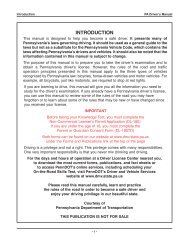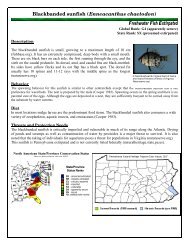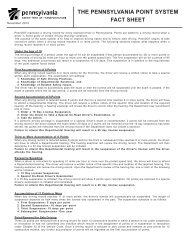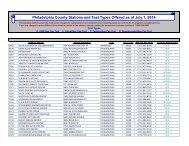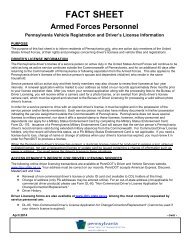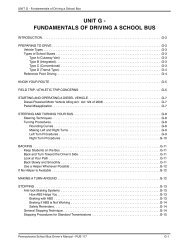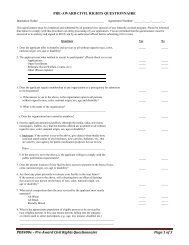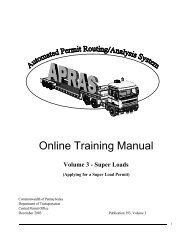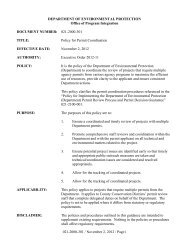Chapter 33: Rules of the Road in General - PennDOT Driver and ...
Chapter 33: Rules of the Road in General - PennDOT Driver and ...
Chapter 33: Rules of the Road in General - PennDOT Driver and ...
Create successful ePaper yourself
Turn your PDF publications into a flip-book with our unique Google optimized e-Paper software.
(b) Traffic-control devices at entrances.--The department, when adopt<strong>in</strong>g anyprohibition under this section, shall erect <strong>and</strong> ma<strong>in</strong>ta<strong>in</strong> <strong>of</strong>ficial trafficcontroldevices at <strong>the</strong> entrances to <strong>the</strong> limited access highway on which <strong>the</strong>prohibitions are applicable <strong>and</strong> when <strong>in</strong> place no person shall disobey <strong>the</strong>restrictions stated on <strong>the</strong> devices.(c) Motorcycles.--Except on busways <strong>in</strong> counties <strong>of</strong> <strong>the</strong> first or second class,motorcycles may be operated upon any limited access highway <strong>in</strong> an urb<strong>and</strong>istrict <strong>in</strong> a lane specified for multioccupant vehicles or car pools, exceptwhere <strong>the</strong> department can demonstrate that such use will create a safetyhazard.(d) Driv<strong>in</strong>g <strong>in</strong> right lane.--(1) Except as provided <strong>in</strong> paragraph (2) <strong>and</strong> unless o<strong>the</strong>rwise posted, upon alllimited access highways hav<strong>in</strong>g two or more lanes for traffic mov<strong>in</strong>g <strong>in</strong> <strong>the</strong>same direction, all vehicles shall be driven <strong>in</strong> <strong>the</strong> right-h<strong>and</strong> lanes whenavailable for traffic except when any <strong>of</strong> <strong>the</strong> follow<strong>in</strong>g conditions exist:(i) When overtak<strong>in</strong>g <strong>and</strong> pass<strong>in</strong>g ano<strong>the</strong>r vehicle proceed<strong>in</strong>g <strong>in</strong> <strong>the</strong> samedirection.(ii) When travel<strong>in</strong>g at a speed greater than <strong>the</strong> traffic flow.(iii) When mov<strong>in</strong>g left to allow traffic to merge.(iv) When prepar<strong>in</strong>g for a left turn at an <strong>in</strong>tersection, exit or <strong>in</strong>to a privateroad or driveway when such left turn is legally permitted.(2) Unless o<strong>the</strong>rwise posted, no vehicle or comb<strong>in</strong>ation over 10,000 pounds maybe driven <strong>in</strong> <strong>the</strong> left-h<strong>and</strong> lane <strong>of</strong> a limited access highway hav<strong>in</strong>g three ormore lanes for traffic mov<strong>in</strong>g <strong>in</strong> <strong>the</strong> same direction except when prepar<strong>in</strong>g fora left turn at an <strong>in</strong>tersection, an exit or <strong>in</strong>to a private road or drivewaywhen such left turn is legally permitted.(Apr. 29, 1994, P.L.148, No.25, eff. 60 days; June 25, 1999, P.L.164, No.23,eff. 180 days; June 26, 2001, P.L.734, No.75, eff. 60 days)2001 Amendment. Act 75 amended subsec. (d).1994 Amendment. Act 25 added subsec. (c).§ <strong>33</strong>14. Prohibit<strong>in</strong>g use <strong>of</strong> hear<strong>in</strong>g impairment devices.(a) <strong>General</strong> rule.--No driver shall operate a vehicle while wear<strong>in</strong>g or us<strong>in</strong>gone or more headphones or earphones.(b) Exception.--This section does not prohibit <strong>the</strong> use <strong>of</strong> hear<strong>in</strong>g aids oro<strong>the</strong>r devices for improv<strong>in</strong>g <strong>the</strong> hear<strong>in</strong>g <strong>of</strong> <strong>the</strong> driver, nor does it prohibit<strong>the</strong> use <strong>of</strong> a headset <strong>in</strong> conjunction with a cellular telephone that onlyprovides sound through one ear <strong>and</strong> allows surround<strong>in</strong>g sounds to be heard with<strong>the</strong> o<strong>the</strong>r ear, nor does it prohibit <strong>the</strong> use <strong>of</strong> communication equipment by <strong>the</strong>driver <strong>of</strong> an emergency vehicle or by motorcycle operators comply<strong>in</strong>g withsection 3525 (relat<strong>in</strong>g to protective equipment for motorcycle riders).(Mar. 29, 1984, P.L.159, No.31, eff. imd.; May 20, 1993, P.L.30, No.10, eff.60 days; July 6, 1995, P.L.315, No.48, eff. 60 days)§ <strong>33</strong>15. Pass<strong>in</strong>g <strong>and</strong> overtak<strong>in</strong>g streetcars.(a) <strong>General</strong> rule.--Notwithst<strong>and</strong><strong>in</strong>g any o<strong>the</strong>r provision <strong>of</strong> this subchapter, <strong>the</strong>driver <strong>of</strong> a vehicle may not overtake <strong>and</strong> pass to <strong>the</strong> left <strong>of</strong> a streetcarproceed<strong>in</strong>g <strong>in</strong> <strong>the</strong> same direction, whe<strong>the</strong>r <strong>the</strong> streetcar is actually <strong>in</strong> motionor temporarily halted to receive or discharge passengers, if overtak<strong>in</strong>g orpass<strong>in</strong>g requires driv<strong>in</strong>g <strong>in</strong> a lane normally used by traffic mov<strong>in</strong>g <strong>in</strong> <strong>the</strong>opposite direction.(b) Streetcar stopped to receive or discharge passengers.--The driver <strong>of</strong> avehicle may not overtake <strong>and</strong> pass a streetcar which has stopped to receive ordischarge passengers on <strong>the</strong> side on which passengers board or alight until<strong>the</strong> doors <strong>of</strong> <strong>the</strong> streetcar are closed <strong>and</strong> passengers who are discharged havereached <strong>the</strong> side <strong>of</strong> <strong>the</strong> highway.



